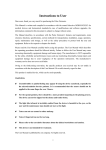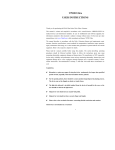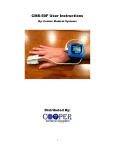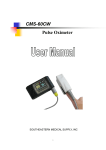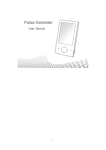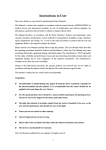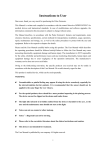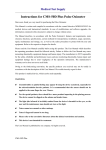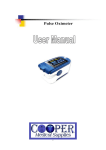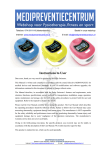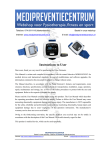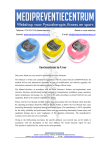Download CMS-50I Instruction Manual
Transcript
I Instructions to User Dear users, thank you very much for purchasing the Pulse Oximeter. This Manual is written and compiled in accordance with the council directive MDD93/42/EEC for medical devices and harmonized standards. In case of modifications and software upgrades, the information contained in this document is subject to change without notice. The Manual describes, in accordance with the Pulse Oximeter’s features and requirements, main structure, functions, specifications, correct methods for transportation, installation, usage, operation, repair, maintenance and storage, etc. As well as the safety procedures to protect both the user and equipment. Refer to the respective chapters for details. Please read the User Manual carefully before using this product. The User Manual which describes the operating procedures should be followed strictly. Failure to follow the User Manual may cause measuring abnormality, equipment damage and human injury. The manufacturer is NOT responsible for the safety, reliability and performance issues and any monitoring abnormality, human injury and equipment damage due to users' negligence of the operation instructions.The manufacturer’s warranty service does not cover such faults. Owing to the forthcoming renovation, the specific products you received may not be totally in accordance with the description of this User Manual. We would sincerely regret for that. This product is medical device, which can be used repeatedly. WARNING: Discomfort or pain may appear if using the device ceaselessly, especially for the microcirculation barrier patients. It is recommended that the pulse oximeter should not be used on the same finger for more than 2 hours. For the special patients, there should be a more prudent inspecting in the placing process. The device can not be clipped on the edema and tender tissue. The light (the infrared is invisible) emitted from the device is harmful to the eyes, so the user and the maintenance man should not look at the light source. Testee can not use enamel or other makeup. Testee’s fingernail can not be too long. Please refer to the correlative literature about the clinical restrictions and caution. This device is not intended for treatment. The User Manual is published by our company. All rights reserved. II Contents 1 Safety .............................................................................................................................................. 1 1.1 Instructions for safe operations ................................................................................................ 1 1.2 Warning .................................................................................................................................... 1 1.3 Attention .................................................................................................................................. 1 2 Overview ........................................................................................................................................ 2 2.1 Features .................................................................................................................................... 2 2.2 Major applications and scope of application............................................................................ 2 2.3 Environment requirements ....................................................................................................... 3 3 Principle ......................................................................................................................................... 3 4 Technical specifications ............................................................................................................... 3 4.1 Main performance .................................................................................................................... 3 4.2 Main Parameters ...................................................................................................................... 4 5 Installation ..................................................................................................................................... 4 5.1 View of the front panel ............................................................................................................ 4 5.2 Probe installation ..................................................................................................................... 5 5.3 Accessories .............................................................................................................................. 5 6 Operating Guide .......................................................................................................................... 5 6.1 Application method.................................................................................................................. 5 6.2 Attention for operation........................................................................................................... 10 6.3 Clinical restrictions ................................................................................................................ 10 7 Maintain、transportation and storage ................................................................................... 11 7.1 Cleaning and Disinfecting...................................................................................................... 11 7.2 Maintain ................................................................................................................................. 11 7.3 Transportation and storage ..................................................................................................... 11 8 Troubleshooting........................................................................................................................... 11 9 Key of Symbols .......................................................................................................................... 12 10 Function Specification ............................................................................................................. 13 III 1 Safety 1.1 Instructions for safe operations Check the main unit and all accessories periodically to make sure that there is no visible damage that may affect patient’s safety and monitoring performance. It is recommended that the device should be inspected weekly at least. When there is obvious damage, stop using the device. Necessary maintenance must be performed by qualified service engineers ONLY. Users are not permitted to maintain it by themselves. The oximeter cannot be used together with devices not specified in User’s Manual. Only the accessory that is appointed or recommendatory by manufacture can be used with this device. This product is calibrated before leaving factory. 1.2 Warning Explosive hazard—DO NOT use the oximeter in the environment with tinder such as anesthetic . DO NOT use the oximeter while the patient is being scanned by MRI or CT. The person who is allergic to rubber can not use this device. The disposal of scrap instrument and its accessories and packing (including battery, plastic bags, foams and paper boxes) should follow the local laws and regulations. Please check the packing before use to make sure the device and accessories are totally in accordance with the packing list, or else the device may have the possibility of working abnormally. Please choose the accessories which are appointed or recommended by the manufacturer for avoiding device damage. Please don't measure this device with functional tester for the device's related information. 1.3 Attention Keep the oximeter away from dust, vibration, corrosive substances, tinder, high temperature and moisture. If the oximeter gets wet, please stop operation. When it is carried from cold environment to warm or humid environment, please do not use it immediately. DO NOT operate button on front panel with sharp things. High temperature or high pressure steam disinfection for the oximeter is not permitted. Refer to User Manual in the relative chapter (7.1) for cleaning and disinfection. Do not have the oximeter immerged in liquid. When it needs cleaning, please wipe its surface with medical alcohol by soft material. Do not spray any liquid on the device directly. When cleaning the device with water, the temperature should be lower than 60℃. The fingers which are too thin or too cold may affect the measure accuracy , please clip the thicker finger such as thumb and middle finger deeply enough into the probe. The oximeter probe which is optional can be used to children. The update period of data is less than 5 seconds, which is changeable according to different individual pulse rate. Please read the measure value when the waveform on screen is equably and steady-going. This measure value is optimal value,and the waveform at the moment is the standard one. 1 If some abnormal conditions appear on the screen during test process, pull the finger out and reinsert to restore normal use. The device has normal life for three years since the first electrified use. The device has alarm function, this function can either be paused, or closed (default setting) for good.Please check the chapter 6.1 as reference. The device has the function of beyond limit alarm.When the measure data is beyond the highest or lowest limit, the device would start alarm automatically on the premise of the alarming function is on. The device may be not fit for all patients. If you are unable to receive approving measure, discontinue use. Do not contort or drag the wire of the device. 2 Overview The pulse oxygen saturation is the percentage of HbO2 in the total Hb in the blood, so-called the O2 concentration in the blood. It is an important bio-parameter for the respiration. A number of diseases relating to respiratory system may cause the decrease of SpO2 in the blood, furthermore, some other causes such as the malfunction of human body's self-adjustment, damages during surgery, and the injuries caused by some medical checkup would also lead to the difficulty of oxygen supply in human body, and the corresponding symptoms would appear as a consequence, such as vertigo, impotence, vomit etc. Serious symptoms might bring danger to human's life. Therefore, prompt information of patients' SpO2 is of great help for the doctor to discover the potential danger, and is of great importance in the clinical medical field. The Pulse Oximeter is small in volume,low in power consumption,convenient in operation and portable. With high-definition display screen,the device is concise and fashion.It is only necessary for patient to put one finger into probe for diagnosis, and the display screen will directly show the SpO2 value,pulse rate value,Perfusion Index value and pulse waveform with the high veracity and repetition. 2.1 Features A B C D E Ultra-thin wrist-design,concise and fashion. Small in volume, light in weight and convenient in carrying. Low power consumption Display direction can be changed automatically,easy to view. Perfusion Index measure. 2.2 Major applications and scope of application The Pulse Oximeter can be used in measuring the pulse oxygen saturation, pulse rate and perfusion index through finger.The product is fit for family, hospital, oxygen bar, community healthcare, physical care in sports (It can be used before or after doing sports and it is not recommended to use the device during the process of having sport) and etc. The problem of overrating would emerge when the patient is suffering from toxicosis which caused by carbon monoxide, the device is not recommended to be used under this circumstance. 2 2.3 Environment requirements Storage Environment a) Temperature :-40℃~+60℃ b) Relative humidity :5%~95% c) Atmospheric pressure :500hPa~1060hPa Operating Environment a) Temperature:10℃~40℃ b) Relative Humidity :30%~75% c) Atmospheric pressure:700hPa~1060hPa 3 Principle Principle of the Oximeter is as follows: An experience formula of data process is established taking use of Lambert Beer Law according to Spectrum Absorption Characteristics of Reductive Hemoglobin (Hb) and Oxyhemoglobin (HbO2) in glow & near-infrared zones. Operation principle of the device is: Photoelectric Oxyhemoglobin Inspection Technology is adopted in accordance with Capacity Pulse Scanning & Recording Technology, so that two beams of different wavelength of lights can be focused onto human nail tip through perspective clamp finger-type sensor. Then measured signal can be obtained by a photosensitive element, information acquired through which will be shown on screen through treatment in electronic circuits and microprocessor. Figure 1 Work elements 4 Technical specifications 4.1 Main performance SpO2 value display Pulse rate value display, bar graph display Pulse waveform display Perfusion Index value display Charge function: Lithium battery is the power supply and can be charged up time and again. Low-power indication: low-power indication symbol appears before working abnormally which is due to low-power. Power-off :long press power button to turn off the device. The display direction can be changed.Short press menu button to change display direction. Screen brightness can be adjusted Pulse sound indication With alarm function With SpO2 value and pulse rate value record function 3 The record data can be uploaded to the computer It can be connected with oximeter probe 4.2 Main Parameters A Measurement of SpO2 Measuring range: 35%~100% Accuracy: 70~100%:±2%;Below 70%:unspecified. B Measurement of pulse rate Measuring range:30bpm~250bpm Accuracy: 30bpm~100bpm:±2bpm;101bpm~250bpm:±2% C Perfusion Index Range: 0%~20% D Resolution SpO2 : 1%, Pulse rate: 1bpm;Perfusion Index:0.1% E Measurement Performance in Weak Filling Condition: SpO2 and pulse rate can be shown correctly when pulse-filling ratio is 0.4%. SpO2 error is ±4%; pulse rate error is ±2 bpm or ±2% (select larger). F Resistance to surrounding light: The deviation between the value measured in the condition of man-made light or indoor natural light and that of darkroom is less than ±1%. G Power supply requirement: 3.6 V DC ~4.2V DC. H Optical Sensor Red light (wavelength is 660nm,6.65mW) Infrared (wavelength is 880nm, 6.75mW) I Adjustable alarm range: SpO2 : 0%~100% Pulse Rate: 0bpm~254bpm 5 Installation 5.1 View of the front panel Alarm setting Time Power indication Pulse sound indication Probe Pulse rate value Perfusion Index Menu button SpO2 value SpO2 alarm low-limit Power button Button Pulse bar graph Pulse waveform Wristband Figure 2 Front View 4 5.2 Probe installation A. Open the USB cover,inserting the probe into the USB port of the pulse oximeter,and the red-light of probe will flicker. B. Insert the finger into the probe (the side with finger sign and the nail should be in the same side ).The connected probe could work normally when the luminescent tube in the device emit red light sostenuto. In order to ensure device life and measure accuracy,external probe is limited to the matching model ,and can't be replaced by other model.Or else the device will be damaged or usage is affected. 5.3 Accessories A. B. C. D. E. A User Manual A power adapter (optional) A data line A disk (PC software) A adult fingertip SpO2 probe (0.3m) and two One-off adhesive SpO2 probe (0.3m) 6 Operating Guide 6.1 Application method 6.1.1 Measurement a. b. c. d. Insert the finger into the probe of the device. Long press power button to turn the device on. Do not shake the finger and keep the patient in a stable state during the process. The data can be read directly from the display screen in the measuring interface. 6.1.2 Lay finger The right method of laying finger is as Figure 3. Figure 3 Fingernails and the luminescent tube should be in the same side. 6.1.3 Pause alarm a. Alarm includes the alarm of measure data's going beyond the limits(SpO2 and pulse rate value), alarm of low-power, and the alarm of finger out. b. In the measuring interface, if the alarm function is on, during the period of alarming, alarm can 5 be suspended by short pressing menu button,and the screen will appear pause-alarm symbol, but the function will be renewed in about 30 seconds. c. If you want to turn off the alarm, you should enter the menu for operation.Please refer to chapter "Alarm setting" for detail. 6.1.4 Change display direction The device could change display direction by manual mode.In the measuring interface,short press menu button to change display direction. 6.1.5 Menu operations In the measuring interface, long press menu button to enter the main menu interface as Figure 4..The user can adjust the settings through the main menu, such as backlight, alarm, data storage,system setting,pulse sound setting,demo. The specific operation methods are as follows: A Brightness adjustment In the main menu interface,short press menu button to move the choice bar to the "Brightness" item,then long press menu button to adjust the brightness of screen (4 levels adjustable). Figure 4 Main Menu Interface B Alarm setting In the main menu interface,short press menu button to move the choice bar to "Alarm” item, then long press menu button to enter the alarm setting menu as Figure 5: 6 Figure 5 Alarm Setting Menu a The high/low limit of alarm setting In alarm setting menu,short press menu button to move the choice bar to "Dir" item,long press menu button to choose Up or Down.Short press menu button to adjust alarm item:SpO2 high limit (SpO2 ALM HI), SpO2 low limit (SpO2 ALM LO), Pulse rate high limit (PR ALM HI), Pulse rate low limit (PR ALM LO).Long press menu button to change the value.Long press menu button once,and the value raise or descend once.The low limit can't be above high limit,and the high limit can't be below the low limit. If the alarm function is on, the device will provide medium-priority alarm signal when the data of SpO2 or pulse rate is beyond the limit. Intermittent alarm will occur and the values show in yellow. Medium priority indicating that prompt operator response is required. b The alarm state setting In alarm setting menu,short press menu button to move the choice bar to the "Alarm" item, then long press menu button to turn on or turn off the alarm sound.Choose “on “to turn on the alarm, and choose “off” to turn off the alarm. c Exit operation In alarm setting menu,short press menu button to move the choice bar to "Exit” item, then long press button to exit alarm setting menu and return to the main menu. C Data record setting In the main menu interface,short press menu button to move the choice bar to the "Record" item,then long press menu button to enter the record setting menu as Figure 6. 7 . Figure 6 Record setting Menu a Record segments Display the number of the data segments which have been recorded. b Record setting In the "Record Menu" interface,short press menu button to move the choice bar to the "Record off" item,then long press menu button to begin to record data;here enter the "Record" menu again,in "Record on" menu,long press menu button to stop recording,and the "on" will become "off". c Delete all In the "Record Menu" interface,short press menu button to move the choice bar to the "Delete all" item,then long press menu button to delete all recorded data. d Exit In the "Record Menu" interface,short press menu button to move the choice bar to "Exit” item, then long press button to exit "record menu" and return to the main menu. D. System setting In the main menu interface,short press menu button to move the choice bar to the "System" item,then long press menu button to enter the system setting menu as Figure 7. Figure 7 System Menu a Hard. Ver. The version number of hardware for the device. b Soft. Ver. The version number of software for the device. c Sound Volume 8 In the "System Menu" interface,short press menu button to move the choice bar to "Sound Volume” item,then long press button to change sound volume step by step (3 levels adjustable). d. Device ID The user can set device ID by PC software.Please refer to <SpO2 Assistant user manual> for details. e. Exit In the "System Menu" interface,short press menu button to move the choice bar to "Exit” item, then long press button to exit "System Menu" and return to the main menu. E. Pulse sound indication setting In the main menu interface,short press menu button to move the choice bar to the "Pulse Sound" item, then long press menu button to turn on or turn off the pulse sound.Choose “on “to turn on pulse sound, and choose “off” to turn off pulse sound. F. Demo setting In the main menu interface, short press menu button to move the choice bar to the "Demo" item,then long press menu button to turn on or turn off "Demo".Choose "on "to turn on Demo,and the demo interface will appear when returning to measure interface;Choose "off " to turn off Demo. G. Exit main menu In the main Menu interface,short press menu button to move the choice bar to "Exit” item, then long press button to exit main Menu and return to the measure interface. H. Clock setting In the measure interface, Short press power button to enter to the clock interface,and long press button to set time."up" means to adjust time upwards,"down" means to adjust time downwards,and long press button for switching.Short press menu button to change setting item (including:hour,minute,year,month,day,week,save,Exit,up/down),and long press menu button to set time which has been chosen. Figure 8 Click setting interface 6.1.6 Charge There are two kinds of charge method: a) Connect the device to computer with data line, then the device should be in charge state. 9 b) Connect the device to power supply with power adaptor, then the device should be in charge state. When charging in power-off state, short press power button and the device will display green dynamic state bar.It means that the device is charging.When the state bar is full,the charging is finished. When charging in power-on state,dynamic Power indication symbol displays. It means that the device is charging.When the state bar is full,the charging is finished. If the alarm function is on, the device will provide high-priority alarm signal when the battery is in low power status .Intermittent alarm sound will occur. High priority indicating requires that operator responds immediately. 6.1.6 Uploading the data (real time data,saved data) Connect the device to computer with data line, then open the PC software.Please refer to <SpO2 Assistant user manual> for detailed operation method of uploading data.The software symbol is as Figure 9. Figure 9 Software symbol 6.2 Attention for operation A. Please check the device before using, and confirm that it can work normally. B.The finger should be in a proper position (see the attached illustration as Figure 3 for reference), or else it may result in inaccurate measure. C.The ray between luminescent tube and photoelectric receiving tube must get across subject’s arteriole. D. The oximeter should not be used at a location or limb tied with arterial canal or blood pressure cuff or receiving intravenous injection. E. Ensure nothing, such as a plaster, can impede the light passage., or else it may result in inaccurate measure of SpO2 ,pulse rate and PI.. F. Excessive ambient light may affect measurement accuracy. It includes fluorescent lamp, dual ruby light, infrared heater, direct sunlight and etc. G.Intense activity of the subject or extreme electrosurgical interference may also affect the accuracy. H.Testee can not use enamel or other makeup. I. Please clean and disinfect the device after operating according to the User Manual (7.1). 6.3 Clinical restrictions A. As the measure is taken on the basis of arteriole pulse, substantial pulsating blood flow of subject is required. For a subject with weak pulse due to shock, low ambient/body temperature, major bleeding,or use of vascular contracting drug, the SpO2 waveform (PLETH) will decrease. In this case, the measurement will be more sensitive to interference. 10 B. For those with a substantial amount of staining dilution drug (such as methylene blue, indigo green and acid indigo blue), or carbon monoxide hemoglobin (COHb), or methionine (Me+Hb) or thiosalicylic hemoglobin, and some with icterus problem, the SpO2 determination by this device may be inaccurate. C. The drugs like dopamine, procaine, prilocaine, lidocaine and butacaine may also be a major factor resulted in serious error of SpO2 measure. D. The SpO2 value serves as a reference value for judgment of anemic anoxia and toxic anoxia, for some patients with serious anemia may also report good SpO2 measurement. 7 Maintain、transportation and storage 7.1 Cleaning and Disinfecting Using medical alcohol to wipe the device for disinfecting, nature dry or clean it with clean soft cloth. 7.2 Maintain A Please clean and disinfect the device before using according to the User Manual (7.1). B Please recharge the battery when the screen shows low-power (the battery power is ). C Recharge the battery soon after the over-discharge. The device should be recharged every six months when it is not regular used. It can extend the battery life following this guidance. D The device needs to be calibrated once a year (or according to the calibrating program of hospital). It also can be performed at the state-appointed agent or just contact us for calibration. 7.3 Transportation and storage A. The packed device can be transported by ordinary conveyance or according to transport contract. The device can not be transported mixed with toxic, harmful, corrosive material. B. The packed device should be stored in room with no corrosive gases and good ventilation. Temperature: -40°C~60°C; Relative Humidity: ≤95% 8 Troubleshooting Trouble Possible Reason Solution The SpO2 and Pulse Rate can not be displayed normally. The finger is not properly positioned. Place the finger properly and try again. The patient’s SpO2 is too low to be detected. Try again; Go to a hospital for a diagnosis if you are sure the device works all right. The SpO2 and Pulse Rate are not displayed stably. The finger is not placed inside deep enough. Place the finger properly and try again. The finger is shaking or the patient is moving. Let the patient keep calm. The device can not be turned on. The battery is drained away or almost drained away. Please charge up battery. The malfunction of the device. Please contact the local service center. 11 The malfunction of the device. Please contact the local service center. The battery is drained away or almost drained away. Please charge up battery. The device can not be used for full time after charge The battery is not full charged. Please recharge the battery The battery is broken Please contact the local service center. The battery can not be full charged even after 10 hours charging time. The battery is broken Please contact the local service center. The display is off suddenly 9 Key of Symbols Signal Description Warning – See User Manual %SpO2 The pulse oxygen saturation (%) PRbpm Pulse rate (bpm) PI Perfusion Index (%) The battery power is full Low-power Close the alarm sound indication Pause the alarm sound indication Open the alarm sound indication Close the pulse sound indication Open the pulse sound indication Menu button power button IPX1 Ingress of liquids rank USB 12 10 Function Specification Information Display Mode The Pulse Oxygen Saturation(SpO2) 2-digit digital OLED display Pulse Rate(PR) 3-digit digital OLED display Perfusion Index (PI) 3-digit digital OLED display Pulse Intensity (bar-graph) bar-graph OLED display SpO2 Parameter Specification Measuring range 0%~100%, (the resolution is 1%). Accuracy 70%~100%:±2% ,Below 70% unspecified. Pulse Parameter Specification Measuring range 30bpm~250bpm, (the resolution is 1bpm) Accuracy 30bpm~100bpm:±2bpm; 101bpm~250bpm:±2% Perfusion Index Specification Range 0%~20%.(the resolution is 0.1%). Accuracy 0%~1%:±0.2%,1%~20%:±1%。 Safety Type Interior Battery,Type BF application part Pulse Intensity Range Continuous bar-graph display, the higher display indicates the stronger pulse. Battery Requirement Voltage 3.7 rechargeable lithium battery × 1 (The red wire on the battery denotes anode,the black wire on the battery denotes cathode.) Battery working life Charge and discharge no less than 500 times. Power Adapter(selected) Output voltage DC 5V 13 Output current 250mA Dimensions and Weight Dimensions 63(L) × 55(W) × 15(H) mm Weight About 45g (with a lithium battery) 14

















